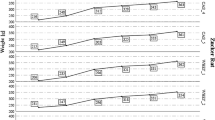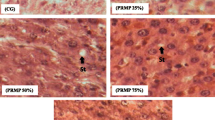Abstract
The inclusion of whey protein concentrates (WPC) in the diet can lead to a decrease in food intake. Considering that excessive food intake and weight gain are correlated with increased oxidative stress and other risk factors, the anorectic action of WPC may have important clinical implications. The aims of the current study were to verify the effects of WPC in comparison with those of casein on food intake, weight, and oxidized glutathione (GSSG) and total glutathione (GSH) concentrations in the blood and liver with or without oxidative stress induced by oral carbon tetrachloride intoxication. Male Sprague-Dawley rats were fed a balanced liquid diet for 3 weeks. Half of the rats received WPC (group P), while the control group received casein (group C). Group P rats ate significantly less than group C rats (p < 0.0001), and their weights decreased significantly. After carbon tetrachloride intoxication, there was a significant increase in GSH in rats of group P compared with the levels in rats of group C both in the liver (GSH group P 4,994 ± 652.6, group C 2,196 ± 323.2 nmol/mg, p < 0.01) and in the blood (GSH group P 1,368 ± 69.56, group C 1,088 ± 48.35 nmol/ml, p < 0.05). These findings indicate that WPC is effective in reducing food intake and preventing weight gain, and it may also play a protective role against oxidative stress by increasing glutathione synthesis in the liver.
Similar content being viewed by others
References
Jean C, Rome S, Mathe V et al (2001) Metabolic evidence for adaptation to a high protein diet in rats. J Nutr 131:91–98
Bensaid A, Tome D, L’Heureux-Bourdon D et al (2003) A high-protein diet enhances satiety without conditioned taste aversion in the rat. Physiol Behav 78:311–320
Hall WL, Millward DJ, Long SJ, Morgan LM (2003) Casein and whey exert different effects on plasma amino acid profiles, gastrointestinal hormone secretion and appetite. Br J Nutr 89:239–248
Boirie Y, Dangin M, Gachon P et al (1997) Slow and fast dietary proteins differently modulate postprandial protein accretion. Proc Natl Acad Sci U S A 94:14930–14935
Fruhneck G (1998) Slow and fast dietary proteins. Nature 391:843–844
Asensi M, Sastre J, Pallardo FV et al (1999) Ratio of reduced to oxidized glutathione as indicator of oxidative stress status and DNA damage. Methods Enzymol 299:267–276
McIntosh GH, Regester GQ, Le Leu RK, Royle PJ (1995) Dairy proteins protect against dimethylhydrazine-induced intestinal cancers in rats. J Nutr 125:809–816
Dröge W (2002) Free radicals in the physiological control of cell function. Physiol Rev 82:47–95
McIntosh GH, Jorgensen L, Royle P (1993) The potential of an insoluble dietary fiber-rich source from barley to protect from DMH-induced intestinal tumours in rats. Nutr Cancer 19:213–221
Pacheco MT, Sgarbieri VC (2005) Effect of different hydrolysates of whey protein on hepatic glutathione content in mice. J Med Food 8:337–342
Lands LC, Grey VL, Smountas AA (1999) Effects of supplementation with a cysteine donor on muscular performance. J Appl Physiol 87:1381–1385
Belobrajdic DP, McIntosh GH, Owens JA (2004) A high-wheyprotein diet reduces body weight gain and alters insulin sensitivity relative to red meat in Wistar rats. J Nutr 134:1454–1458
Keaney JF Jr, Larson MG, Vasan RS et al (2003) Framingham Study. Obesity and systemic oxidative stress: clinical correlates of oxidative stress in the Framingham Study. Arterioscler Thromb Vasc Biol 23:434–439
Roskams T, Yang SQ, Koteish A et al (2003) Oxidative stress and oval cell accumulation in mice and humans with alcoholic and non-alcoholic fatty liver disease. Am J Pathol 163:1301–1311
Olusi SO (2002) Obesity is an independent risk factor for plasma lipid peroxidation and depletion of erythrocyte cytoprotective enzymes in humans. Int J Obes Relat Metab Disord 26:1159–1164
Hensley K, Floyd RA (2002) Reactive oxygen species and protein oxidation in aging: a look back, a look ahead. Arch Biochem Biophys 397:377–383
Mariotti F, Simbelie KL, Makarios-Lahham L et al (2004) Acute ingestion of dietary proteins improves post-exercise liver glutathione in rats in a dose-dependent relationship with their cysteine content. J Nutr 134:128–131
Ritter C, Reinke A, Andrades M et al (2004) Protective effect of N-acetylcysteine and deferoxamine on carbon tetrachloride-induced acute hepatic failure in rats. Crit Care Med 32:2079–2083
Dwivedi S, Sharma R, Sharma A et al (2006) The course of CCl4 induced hepatotoxicity is altered in mGSTA4-4 null (-/-) mice. Toxicology 218:58–66
Aneja R, Upadhyaya G, Prakash S et al (2005) Ameliorating effect of phytoestrogens on CCL4-induced oxidative stress in the livers of male Wistar rats. Artif Cells Blood Substit Immobil Biotechnol 33:201–213
Basu S (2003) Carbon tetrachloride-induced lipid peroxidation: eicosanoid formation and their regulation by antioxidant nutrients. Toxicology 189:113–127
Lieber CS, Decarli LM (1989) Liquid diet technique of ethanol administration: 1989 update. Alcohol Alcohol 24:197–211
Reeves PG, Nielsen FH. Fahey GC (1993) AIN-93 purified diets for laboratory rodents: final report al the American Institute of Nutrition ad hoc writing committee on the reformulation of the AIN-76A rodent diet. J Nutr 123:1939–1951
Fariss MW, Reed DJ (1987) High-performance liquid chromatography of thiols and disulfides: dinitrophenol derivatives. Methods Enzymol 143:101–109
Furukawa S, Fujita T, Shimabukuro M et al (2004) Increased oxidative stress in obesity and its impact on metabolic syndrome. J Clin Invest 114:1752–1761
Rossi R, Milzani A, Dalle-Donne I et al (2002) Blood glutathione disulfide: in vivo factor or in vitro artifact? Clin Chem 48:742–753
Noelle RJ, Lawrence DA (1981) Determination of glutathione in lymphocytes and possible association of redox state and proliferative capacity of lymphocytes. Biochem J 198:571–579
Feinle C, O’Donovan D, Doran S et al (2003) Effects of fat digestion on appetite, APD motility, and gut hormones in response to duodenal fat infusion in humans. Am J Physiol Gastrointest Liver Physiol 284:G798–G807
Dangin M, Boirie Y, Guillet C, Beaufrere B (2002) Influence of the protein digestion rate on protein turnover in young and elderly subjects. J Nutr 132:3228S–3233S
Bowen J, Noakes M, Clifton P et al (2004) Effect of dietary proteins on appetite, energy intake and glycemic response in overweight men. Asia Pac J Clin Nutr 13[Suppl]:S64
Hum S, Koski KG, Hoffer LJ (1992) Varied protein intake alters glutathione metabolism in rats. J Nutr 122:2010–2018
Dröge W (1999) Cysteine and glutathione in catabolic conditions and immunological dysfunction. Curr Opin Clin Nutr Metab Care 2:227–233
Parker NT, Goodrum KJ (1990) A comparison of casein, lactalbumin, and soy protein effect on the immune response to a Tdependent antigen. Nutr Res 10:781–792
Wong CW, Watson DL (1995) Immunomodulatory effects of dietary whey proteins in mice. J Dairy Res 62:350–368
Bounous G, Létourneau L, Kongshavn PA (1983) Influence of dietary protein type on the immune system of mice. J Nutr 113:1415–1421
Bounous G, Batist G, Gold P (1989) Immunoenhancing property of dietary whey protein in mice: role of glutathione. Clin Invest Med 12:154–161
Ames BN, Shigenaga MK, Hagen TM (1993) Oxidants, antioxidants, and the degenerative diseases of aging. Proc Natl Acad Sci U S A 90:7915–7922
Beckman KB, Ames BN (1998) The free radical theory of aging matures. Physiol Rev 78:547–581
Lee CK, Klopp RG, Weindruch R, Prolla TA (1999) Gene expression profile of aging and its retardation by caloric restriction. Science 285:1390–1393
Lee CK, Weindruch R, Prolla TA (2000) Gene expression profile of the aging brain in mice. Nat Genet 25:294–297
Sohal RS, Weindruch R (1996) Oxidative stress, caloric restriction, and ageing. Science 273:59–63
Zainal TA, Oberley TD, Allison DB et al (2000) Caloric restriction of rhesus monkeys lowers oxidative damage in skeletal muscle. FASEB J 14:1825–1836
Hack V, Breitkreutz R, Kinscherf R et al (1998) The redox state as a correlate of senescence and wasting and as a target for therapeutic intervention. Blood 92:59–67
Ji LL, Dillon D, Wu E (1990) Alteration of antioxidant enzymes with aging in rat skeletal muscle and liver. Am J Physiol. 258:R918–R923
Dangin M, Guillet C, Garcia-Rodenas C et al (2003) The rate of protein digestion affects protein gain differently during aging in humans. J Physiol 549:635–644
Miquel J, Ferrandiz ML, de Juan E et al (1995) N-acetylcysteine protects against age-related decline of oxidative phosphorylation in liver mitochondria. Eur J Pharmacol 292:333–335
Author information
Authors and Affiliations
Corresponding author
About this article
Cite this article
Sukkar, S.G., Cella, F., Patriarca, S. et al. Whey protein, as exclusively nitrogen source, controls food intake and promotes glutathione antioxidant protection in Sprague-Dawley rats. Mediterr J Nutr Metab 1, 109–116 (2008). https://doi.org/10.1007/s12349-008-0017-0
Received:
Accepted:
Published:
Issue Date:
DOI: https://doi.org/10.1007/s12349-008-0017-0




